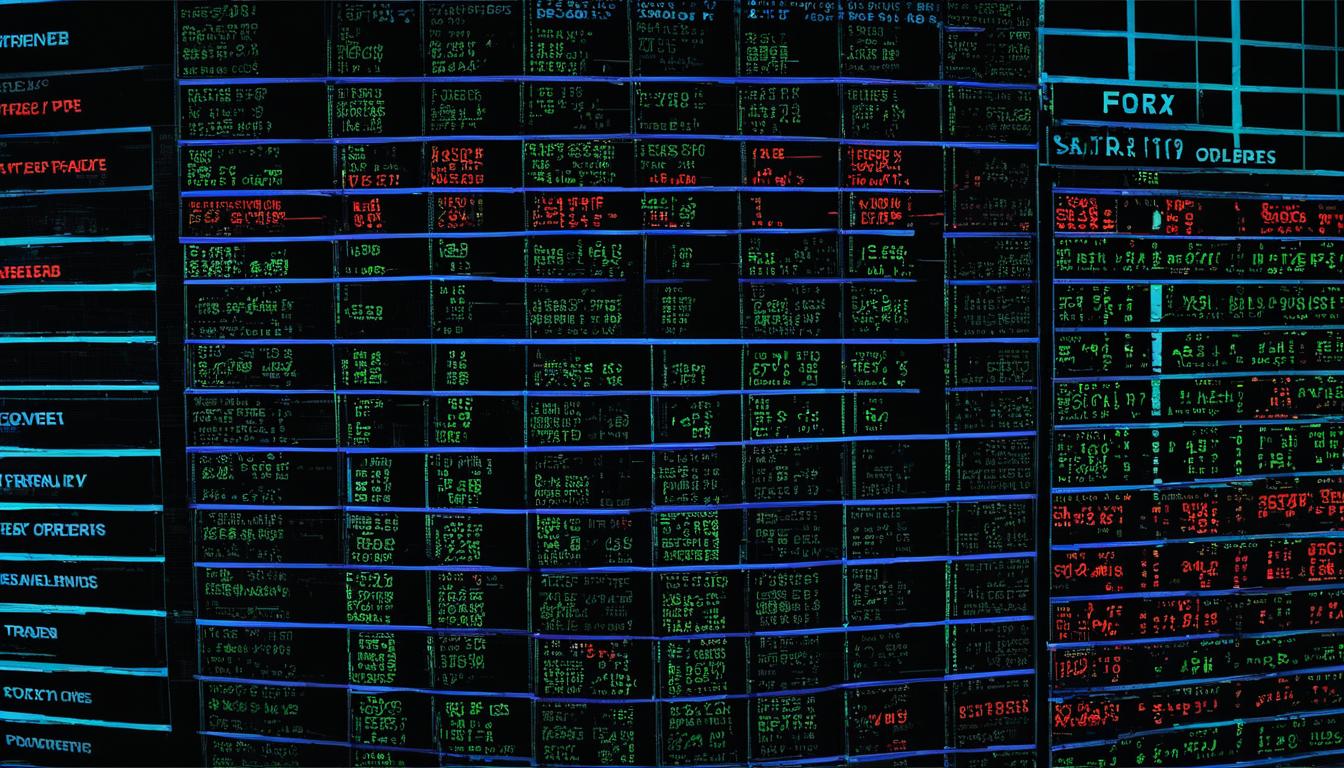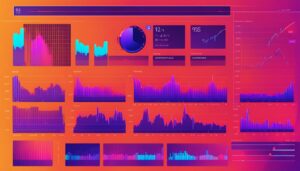In the world of Forex trading, understanding the different types of orders is crucial for success. There are two main categories of orders: market orders and pending orders. Market orders are executed instantly at the best available price, while pending orders are executed at a later time based on specified conditions. It’s important to know the various types of orders your broker accepts.
Key Takeaways:
- Market orders are executed immediately at the current market price.
- Pending orders allow traders to set specific conditions for execution at a later time.
- Limit orders are used to enter or exit the market at a desired price level.
- Stop orders are triggered when the price reaches a certain level for entry or exit.
- OCO and OTO orders are conditional orders that enhance trading precision and minimize risk.
Market Orders
A market order is an instruction to buy or sell a currency pair at the current market price. It provides immediate access to the market and is useful for taking advantage of rapidly changing prices.
When you place a market order, you have no control over the exact price at which it will be filled, as it depends on market conditions. However, market orders are helpful during volatile periods and time-sensitive situations.
Market orders offer simplicity and speed of execution but lack the precision of other order types. They are commonly used when the priority is to enter or exit a position quickly, without regard to the specific execution price.
“Market orders are like jumping into the stream of a fast-moving river. You get in quickly, but you have little control over where you’ll end up.”
Executing a market order guarantees that the trade will be filled promptly, as long as there is an available counterparty in the market. This type of order is especially beneficial when trading highly liquid currency pairs with narrow bid-ask spreads.
Market orders are also commonly used when trading news releases or during periods of significant market volatility. Taking advantage of the current market price without delays can be essential in these situations.
Pending Orders
Pending orders are an essential tool in Forex trading as they allow traders to execute transactions based on specific conditions. These orders are executed at a later time, ensuring that traders have more control over their entry and exit points. Let’s explore some of the most common types of pending orders:
Entry Orders
An entry order is a type of pending order that instructs the broker to open a position once the market reaches a specified price level. Traders can set a buy or sell entry order depending on their market expectations. This type of order helps traders enter the market at their desired price, even if they are not actively monitoring it.
Good ‘Til Canceled (GTC) Orders
GTC orders remain active until the trader cancels them or until they are executed. Traders can place a GTC order to buy or sell a currency pair at a specific price, and it will remain in the market until the conditions are met. GTC orders are beneficial for traders who prefer long-term strategies and want to hold their positions until specific market movements occur.
Fill or Kill Orders
Fill or Kill (FOK) orders are executed immediately or cancelled if they cannot be filled. Traders use FOK orders when they want to ensure that their order is either executed entirely or not at all. This type of order is particularly useful when trading highly volatile markets where rapid price movements can lead to partial fills or missed opportunities.
Pending orders provide traders with greater flexibility and precision in executing their trading strategies. By using entry orders, GTC orders, and Fill or Kill orders, traders can optimize their trading positions and react to market conditions more effectively.
Limit Orders
A limit order is an order to buy or sell a currency pair at a specified price or better. It is a useful tool for entering or exiting the market at a desired price level. When placing a limit order, traders can set the price at which they are willing to buy or sell a currency pair.
A buy limit order is placed below the current market price, indicating that the trader wants to buy the currency pair at a lower price than what is currently available. This strategy allows traders to take advantage of potential price dips or pullbacks before entering a position.
On the other hand, a sell limit order is placed above the current market price, suggesting that the trader wants to sell the currency pair at a higher price than the current market value. This method allows traders to profit from potential price increases or bounces before exiting a position.
Limit orders are particularly advantageous during volatile market conditions when prices can fluctuate rapidly. By setting specific price levels, traders can ensure that their orders are executed at the desired prices, even if the market moves quickly.
Take-Profit Orders
Take-profit orders are a type of limit order used to automatically close a trade when it reaches a specified profit level. Traders can set a target price at which they want to close their position to secure profits.
When placing a take-profit order, traders determine the profit they wish to achieve and set a price level accordingly. Once the market reaches this predefined level, the take-profit order is executed, closing the trade and locking in the desired profit.
Take-profit orders are valuable tools for managing trades and adhering to predefined profit targets. They allow traders to automate the process of closing profitable positions, reducing the need for constant monitoring and manual intervention.
Stop Orders
Stop orders are a crucial tool in Forex trading, providing traders with the ability to enter or exit the market at specific price levels. These orders are triggered when the market price reaches a predetermined stop price, allowing for precise trade execution.
One type of stop order is the stop-loss order. This order is designed to protect traders from significant losses by automatically closing a trade when the price goes against them. By setting a stop-loss order, traders can manage their risk and limit potential losses.
Another type of stop order is the trailing stop order. This order is especially useful when traders want to secure their profits as the market moves in their favor. The trailing stop order adjusts automatically with the market price, locking in profits and protecting against potential reversals.
Let’s take a closer look at the different types of stop orders:
| Stop Order Type | Description |
|---|---|
| Stop-Loss Order | An order used to close a trade and limit losses if the price goes against the trader. |
| Trailing Stop Order | An order that adjusts with the market price, locking in profits as the price moves in the trader’s favor. |
Implementing stop orders in your trading strategy can help you manage risk, protect your capital, and maximize profits. By setting stop-loss orders, you can limit potential losses and avoid emotional trading decisions. Trailing stop orders, on the other hand, allow you to lock in profits as the market moves in your favor, ensuring you make the most of profitable trades.
Remember, always analyze the market and set stop orders based on your trading plan and risk tolerance. Utilizing these stop orders effectively can significantly improve your trading performance in the dynamic Forex market.

Now that we’ve covered stop orders, let’s explore another important type of Forex order: OCO (One Cancels the Other) orders and One-Triggers-the-Other orders. These conditional orders provide traders with even more control and flexibility when executing their trading strategies.
OCO Orders and One-Triggers-the-Other Orders
In the world of Forex trading, OCO (One Cancels the Other) orders and OTO (One-Triggers-the-Other) orders are powerful tools that provide traders with greater control over their trades. These conditional orders allow traders to set specific instructions for buying and selling currencies, ensuring that their predetermined entry and exit points are executed seamlessly.
When it comes to OCO orders, traders have the option to place two separate instructions: one to buy and one to sell. The beauty of this order type is that when one instruction is executed, the other is automatically cancelled. This means that traders can place an OCO order with both a stop-loss order and a take-profit order, protecting their downside and securing their profits.
On the other hand, One-Triggers-the-Other (OTO) orders execute trades when certain conditions are met. Imagine a scenario where a trader wants to buy a currency pair if it breaks above a certain resistance level and sell it if it falls below a specific support level. By using an OTO order, the trader sets these conditions, and once one of them is triggered, the corresponding buy or sell order is executed.
These types of orders provide traders with enhanced control and risk management capabilities. By setting predetermined entry and exit points, traders can execute their trades with precision, minimizing their exposure and maximizing their potential profits. OCO and OTO orders offer great flexibility, allowing traders to adapt to changing market conditions and execute their strategies effectively.
Conclusion
Understanding the different types of Forex orders is crucial for successful trading. Whether you’re a beginner or an experienced trader, knowing how each order works and when to use them can greatly impact your trading strategy and overall profitability.
Market orders provide immediate execution at the best available price, allowing you to take advantage of rapidly changing market conditions. On the other hand, pending orders offer more control over entry and exit points, allowing you to set specific conditions for trade execution.
Limit orders are useful for entering or exiting the market at a specified price or better, while stop orders help manage risk by triggering trade execution when the price reaches a certain level. These orders can help you execute trades more efficiently and ensure you’re not caught off guard by unfavorable market movements.
Additionally, OCO (One Cancels the Other) and OTO (One-Triggers-the-Other) orders provide added flexibility and precision in your trading strategy. They allow you to set predetermined entry and exit points, reducing the need for constant monitoring and helping you optimize your trading performance.
By utilizing these various order types, traders can enhance their order execution, control their risk, and improve their chances of success in the dynamic Forex market. So, take the time to understand and master these order types, as they are essential tools in your trading toolkit.
FAQ
What are the different types of Forex orders?
The different types of Forex orders are market orders, pending orders, limit orders, stop orders, and OCO (One Cancels the Other) orders.
What is a market order?
A market order is an instruction to buy or sell a currency pair at the current market price. It provides immediate access to the market and is useful for taking advantage of rapidly changing prices.
What is a pending order?
A pending order is executed at a later time based on specific conditions set by the trader. There are several types of pending orders, including entry orders, Good ‘Til Canceled (GTC) orders, and Fill or Kill orders.
What is a limit order?
A limit order is an order to buy or sell a currency pair at a specified price or better. It is used to enter or exit the market at a desired price level. A buy limit order is placed below the current market price, while a sell limit order is placed above it.
What is a stop order?
A stop order is used to either enter or exit the market when the price reaches a certain level. A stop order to enter a trade is triggered when the market price passes a specified stop price. A stop-loss order is a type of stop order used to close a trade and limit losses if the price goes against the trader. A trailing stop order is a type of stop order that adjusts with the market and locks in profits as the price moves in the trader’s favor.
What are OCO (One Cancels the Other) orders?
OCO orders are a type of conditional order that consists of two separate instructions: one to buy and one to sell. When either instruction is executed, the other is automatically canceled. They allow traders to set predetermined entry and exit points, maximizing their control and minimizing risk.
What are One-Triggers-the-Other (OTO) orders?
OTO orders are also conditional orders that execute trades when certain conditions are met. They allow traders to set predetermined entry and exit points, helping them optimize their trading strategy and minimize risk.
Why is it important to understand the different types of Forex orders?
Understanding the different types of Forex orders is crucial for effective trading. It allows traders to navigate the market, control their entry and exit points, and manage risk more effectively, ultimately improving their chances of success.





